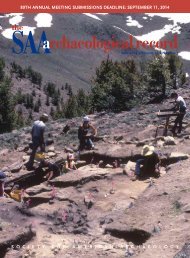SAA
Nov2016_web
Nov2016_web
Create successful ePaper yourself
Turn your PDF publications into a flip-book with our unique Google optimized e-Paper software.
VIDEO GAMES AND ARCHAEOLOGY<br />
When operating within digital gaming spaces, there are two<br />
potential setbacks that must be overcome when setting a policy<br />
of ethical interaction. The first set of problems is technical<br />
in nature, arising from the particular bounds and<br />
limitations of how immaterial spaces of play function. The<br />
second set of problems is community-based in nature, arising<br />
from the ways in which dispersed digital populations<br />
organize themselves, behave, and often, misbehave.<br />
Figure 1. The artifacts in Tomb Raider are generalized depictions based<br />
on real cultural objects, lending an authenticity to Lara Croft’s discoveries<br />
that is made more problematic by how, as an archaeologist, she<br />
approaches their collection and retention.<br />
Focusing on the technical issues is best undertaken on a<br />
case-by-case basis, as each game product will have different<br />
constraints inherent in its design (Reinhard 2015). In this<br />
way, the technical concerns of archaeogaming are as individual<br />
as each real-world fieldwork proposal, varied as they<br />
might be because of environmental conditions and countryspecific<br />
legal requirements. The community issues related to<br />
archaeogaming research, however, can be more generally<br />
approached and wider issues of ethical practice addressed.<br />
access, obtaining informed consent, guaranteeing confidentiality,<br />
and promoting the responsible publication of data, a<br />
set of norms developed through academic and commercial<br />
practice as to how work is to be conducted ethically. This set<br />
of norms, however, does not transfer directly into ethical<br />
practice within virtual spaces such as video games, presenting<br />
researchers within those spaces with new issues of<br />
appropriateness to consider (Wijaya et al. 2013). As<br />
archaeogaming attracts more scholarly contributions, it is<br />
crucial to establish an ethical framework that works within<br />
the particular challenges of researching in virtual spaces like<br />
games, and interacting with virtual communities, such as<br />
with those individuals who organize into highly stratified,<br />
closed-to-the-public, often competitive, clans and guilds for<br />
shared play in World of Warcraft.<br />
Working within a game world is not that different from more<br />
traditional archaeological fieldwork, except for the potential<br />
comfort of one’s chair. The same problems in study arise. The<br />
same issues of ethical practice arise. Those the archaeologist<br />
interacts with may have monitors dispersed over the whole of<br />
the world, but they still have to be considered as a community<br />
and treated as actors with agency and rights. Appropriate<br />
measures for securing access, for obtaining informed consent,<br />
for guaranteeing confidentiality, and for promoting the<br />
responsible publication of data are all aspects of the<br />
archaeogaming process that require attention in planning<br />
and execution. Unfortunately, accomplishing those tasks can<br />
be made more difficult because of the digital format.<br />
Researching in a Single-Player Environment<br />
Digital game spaces come in two types, single-player and<br />
multiplayer. Single-player games are games in which the<br />
player is the only “real” person in the game, and all other<br />
“people” encountered are characters programmed by the<br />
game’s developers. An example of a single-player game is<br />
Super Mario Brothers. Multiplayer games are games in which<br />
many “real” people interact with each other within the game.<br />
An example of a multiplayer game is League of Legends.<br />
For a researcher, single-player games require considerations<br />
of ethical versus unethical action and participation in a predetermined<br />
narrative. Simply put, as the only player in those<br />
games, the researcher doesn’t have to consider how she interacts<br />
with other people, but instead how she behaves within<br />
the narrative and world presented by the game’s designers.<br />
One area of concern with the ethics of archaeogaming is the<br />
potential for participation in game-located looting activities.<br />
When the practicing archaeologist is researching gaming,<br />
does the archeologist engage in looting artifacts or objects of<br />
cultural patrimony, as that looting and collection is part of<br />
the predetermined game structure, or does the archaeologist<br />
abstain? Abstention means potentially missing access to content<br />
that may be gated through participation, or lack of participation,<br />
but participation means perpetuating an<br />
entertainment narrative of looting as acceptable behavior<br />
(Figure 2). While within the material world, the ramifications<br />
of looting are well established and understood, the<br />
question of whether to loot in a single-player environment<br />
where no one will be directly, immediately impacted but the<br />
30 The <strong>SAA</strong> Archaeological Record • November 2016




